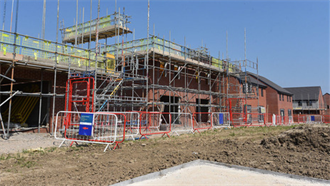As more and more property owners start taking carbon emissions seriously, heat mapping is one way they can make big strides in their journey to achieving net zero carbon.
Tackling the topic of decarbonisation – also known as ‘target net zero’ – can present as a complicated undertaking. For example, an asset may come freighted with substantial amounts of historical Co2 ‘captured’ within it from its construction.
Meanwhile, moving the needle of an asset’s emissions often involves significant capital spending on complex infrastructure like heating systems, which are responsible for a significant portion of a building’s total emissions.
In short, it can seem like the short-term benefits of going ‘net zero’ are difficult to discern, whereas the financial costs are not. Despite this, in leading markets the business and regulatory environments are steadily evolving to privilege environmentally friendly buildings and to punish ‘dirty’ – carbon emitting – ones.
In the UK, the government’s heat and buildings strategy proposes to ban new gas boilers in the residential sector from 2025. In Spain and Portugal, the national electricity grids are decarbonising quickly. Inefficient gas boilers are being phased out in favour of more eco-friendly technology like heat pumps in a bid to achieve higher EPC ratings, more rapidly.
Meanwhile on the markets, private and institutional investors increasingly shun for reputational reasons dirty, carbon-spewing buildings from their sleek, sustainable portfolios, often in order to uphold lofty goals embodied in ambitious environmental, social and governance (ESG) agendas.
In the past 12 months alone, a string of major property players announced their portfolios will be carbon-free by 2050, latest. These included Cushman & Wakefield, LGIM, Covivio, M&G Real Estate, BMO Real Estate Partners, and others.
Net zero drive
Elsewhere, a sustainability report by RICS and the World Built Environment Forum, published in H2 last year, reported that more than half (55%) of survey respondents said their clients care more than ever about hitting ‘net zero’ benchmarks.
All around, the incentives are becoming more concrete for adopting a proactive stance on decarbonisation. Indeed, there’s mounting evidence of a direct link between a building’s sustainability credentials and its market value.
In late 2021, property adviser CBRE published research revealing a 21% rental premium for certified office buildings compared to non-certified assets, over a five-year period in Europe. Indeed, this premium was even higher in some leading cities, such as Copenhagen (29%), Barcelona (27%) and Amsterdam (26%).
Other research also supports the claim of a correlation between a building’s ability to contribute to ‘net zero’ goals and its market value. Since 2016, take-up of certified buildings in European markets has steadily risen to almost a third of the total take-up (31%), from under a quarter (24%), five years ago, CBRE found.
So how do asset owners and managers actually address decarbonisation?
A heat mapper offers a quick and easy way to build an accurate picture of what is going on inside a building, and to identify key areas for potential cost and carbon savings. Also available is a service called pathway analysis. This is the next level, providing detailed and unbiased insights into which strategies will deliver the best returns in terms of cost or carbon.
Leading suppliers in this segment such as Verco provide a suite of precision technology and services. They do not just focus on heating systems, either. Verco is an award-winning energy management and sustainability business with 30 years' experience at the cutting edge of the low-carbon economy. Its heat mapper and pathway analysis also put ventilation and air conditioning infrastructure under the microscope.
The good news is that starting the journey to net zero is as simple as downloading Verco’s new free heat mapper, here.
But why the focus upon heating? Andries van der Walt, Director (Real Estate) at Verco, explains:
‘Heat decarbonisation is a key lever that property owners need to pull in the journey to achieving net zero carbon. Heating systems have a long lifespan and are costly and cumbersome to change.
‘The opportunities for making big strides are few and far between, meaning that failure to fully consider options when these opportunities arise, can lock in carbon emissions for a long period of time,’ he says.
Capital allocators closely track their exposure to both physical and transitional climate-related risk factors, meaning investors are unlikely to favour property owners and managers who ignore opportunities to decarbonise assets when they arise.
Indeed, the price of not taking carbon emissions seriously is mounting. CBRE’s recent study even put a figure upon it, in terms of asset vacancy rates by city.
It found that during the first six months of 2021, certified buildings across the EU showed lower vacancy rates and increased leasing velocity, compared to the whole market average. In Paris – a hotspot for logistics and office – the performance gap was stark. The French capital city’s overall vacancy rate stood at 6.7%. But for certified buildings it plummeted to only 1.5%. International player JLL recently made a similar finding, that strong demand exists for sustainable, ‘healthy,’ buildings.
Even during a time when the global health crisis was disrupting the commercial property sector by causing offices to empty out and turning retail districts into ghost towns, buildings which demonstrated commitment to ‘net zero’ goals performed better.
Green loans
Meanwhile in the area of finance, innovative ‘green loans’ which offer cheaper borrowing are increasingly common. These instruments work by linking the cost of debt to the performance of assets in meeting ESG objectives. Under a green loan, achieving carbon targets makes borrowing cheaper. But these loans are not available to owners whose property portfolios don’t come up to scratch on Co2, as crystallised in ESG strategies.
The past year has seen several leading companies in Europe ink their maiden green loan deal to unlock savings, including Hines, Generali Real Estate, Altarea, Grosvenor, Aviva Investors, and others. Green loans also provide a concrete way for companies to show their ESG agendas have substance and are not ‘greenwashing’ PR exercises.
Broadly, it seems that the direction of travel is set on the road to ‘net zero,’ by the middle of the century. The good news for asset owners and managers is that there are tools and services available to help seize the opportunities of decarbonisation.
Van der Walt of Verco, says: ‘We help industry leaders set targets and deliver them as well, with advice which is commercially viable, realistic and achievable in the real world. We offer two tools which help real estate businesses accelerate their journey to net zero carbon, from whichever point they are at. We can support everyone on their journey to net zero carbon, not just those at the front.’



































